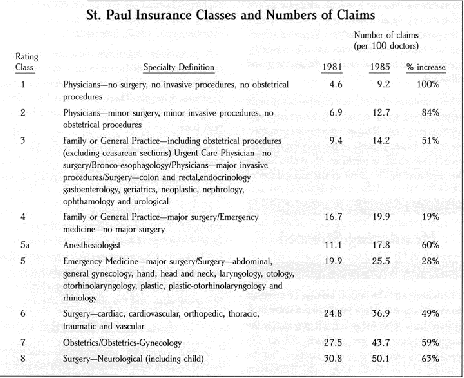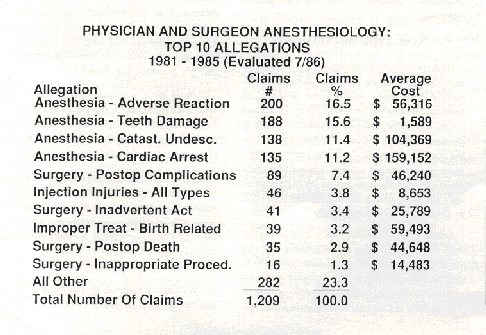Number Rises More Slowly But Severity Remains High
In the past, anesthesiologists were viewed as a high-risk group by professional liability insurers. The risks of using anesthesia and the frequency and catastrophic nature of anesthesia claims contributed to this view.
However, during the past several years, the loss experience of anesthesiologists has improved. Claim frequency has increased for all physicians, but relative to other specialties, claims reported by anesthesiologists have increased more slowly, according to the St. Paul Fire and Marine Insurance Co.
Between 1979 and 1985, claims reported by all physicians increased in frequency by 76.3 percent. During the same time period, claims reported by anesthesiologists increased 32.6 percent.
In 1979, the frequency of claims reports by anesthesiologists was 39 percent higher than the average for all physicians. By 1985 the same figure decreased to 4.7 percent above the average claim frequency for all physicians.
Because of this improvement, St. Paul Insurance reduced the rate relativity of anesthesiologists from 5.0 to 4.0, effective July 1, 1985. Anesthesiologists now pay less for their professional liability coverage than they would with a 5.0 relativity factor.
At the same time, St. Paul created a new rating classification, Class 5a, for anesthesiologists alone. The new class retains the lower relativity factor based on improved claim experience. Previously, anesthesiologists were groups with otorhinolaryngological, general and plastic surgeons, among others (see box on page 23).
Lower frequency of claims for anesthesiologists is due to many factors. Anesthesiologists’ longstanding concern for patient safety, improvement of anesthetic technique, and utilization of new medical technology all appear to have helped reduce frequency of claims.
Progress has also come from the concern of anesthesiologists, nurse anesthetists, and others interested in studying anesthesia claims. Their efforts help determine where accidents occur and what can be done to avoid them.
In addition, monitoring standards passed by the American Society of Anesthesiologists establish and endorse high-quality patient care through basic intraoperative monitoring. Providers who practice in accordance with these standards and take advantage of technological advances will further help reduce claims.
Although frequency of anesthesia-related claims has been reduced, severity of claims remains high relative to that of most other physicians. As shown in the accompanying table, when losses do occur, many continue to be catastrophic in nature.


Recent closed-claim studies show that a large number of anesthesia-related claims involve unrecognized perioperative hypoxia. By using monitoring equipment such as the end4idal C02 monitor for ventilation and the pulse oximeter for oxygenation anesthesia providers can identify the soon-to-be or actually hypoxic patient before any injury and thus make a positive impact on catastrophic claims by reducing hypoxia-related injuries.
Anesthesiologists have reduced the over-all frequency of anesthesia-related claims. With continued effort and concern for patient safety, anesthesiologists can also impact the frequency of catastrophic claims and further improve their professional liability rates.
Mr. Wood is Medical Services Manager, Risk Management, St. Paul Insurance, and a member of the Newsletter Editorial Board

